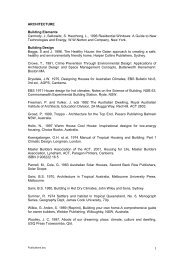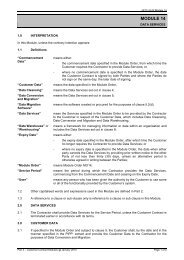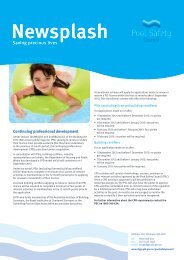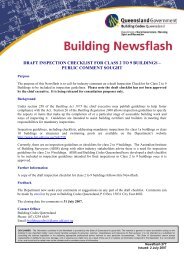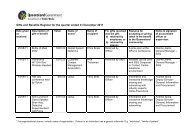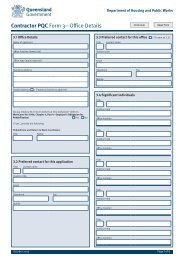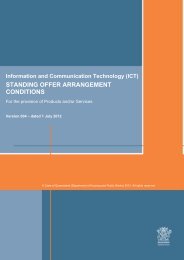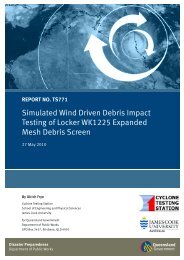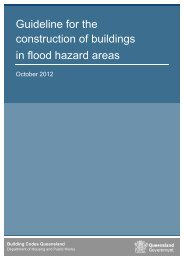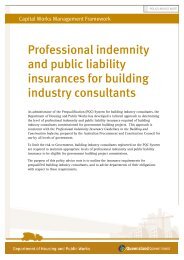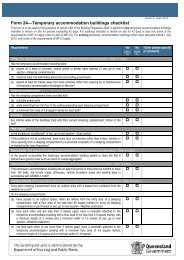QFleet Road Safety Manual - Department of Housing and Public ...
QFleet Road Safety Manual - Department of Housing and Public ...
QFleet Road Safety Manual - Department of Housing and Public ...
You also want an ePaper? Increase the reach of your titles
YUMPU automatically turns print PDFs into web optimized ePapers that Google loves.
As part <strong>of</strong> the program to promote safe driving, the<br />
following information about vehicle <strong>and</strong> driver safety<br />
should be provided:<br />
• Information about driving hazards (e.g. impact <strong>of</strong><br />
wet road conditions on safe following distances)<br />
– see Rural <strong>and</strong> remote driving in the <strong>QFleet</strong> Safe<br />
Driving Guide.<br />
• Agency specific, statistical information about<br />
crash risks (percentages <strong>of</strong> fleet vehicles involved<br />
in crashes) <strong>and</strong> reporting <strong>of</strong> crashes – see Crash<br />
reporting <strong>and</strong> monitoring in the Safe Driving<br />
Guide.<br />
• Information about how drugs <strong>and</strong> alcohol affect<br />
driving (e.g. relationship between Blood Alcohol<br />
Concentration (BAC) levels <strong>and</strong> reaction times) –<br />
see Fitness to drive in the Safe Driving Guide.<br />
• Information about the effect <strong>of</strong> medications on<br />
driving (e.g. impact <strong>of</strong> drowsiness on driving) –<br />
see Fitness to drive in the Safe Driving Guide.<br />
• Information about fatigue <strong>and</strong> driving (e.g. how<br />
the body clock works) – see Courteous <strong>and</strong> Safe<br />
Driving Behaviour in the Safe Driving Guide.<br />
The <strong>QFleet</strong> Safe Driving Guide also provides a range<br />
<strong>of</strong> other information fact sheets.<br />
Direct supervision <strong>of</strong> drivers is rarely possible, so<br />
the emphasis must be on monitoring the procedures<br />
designed to reduce risks.<br />
Supervisors need to respond to any incidents/<br />
infringements, feedback from drivers <strong>and</strong> issues<br />
raised in forums such as WHS committees or work<br />
group meetings.<br />
In addition, supervisors need to actively promote<br />
safe driving <strong>and</strong> address any evidence <strong>of</strong> unsafe<br />
driving.<br />
Plan trips to minimise risks<br />
For regular driving journeys, planning can minimise<br />
risks. Time should always be allocated to account for<br />
travel as well as common delays, such as traffic <strong>and</strong><br />
weather conditions.<br />
If a safer route is available, then drivers should be<br />
instructed to use it.<br />
Consideration should be given to using more<br />
appropriate TravelSmart alternatives such as public<br />
transport, taxis or technological options such as<br />
video conferencing. The time allocated to reach<br />
a destination should not require the driver to not<br />
comply with road rules.<br />
Work involving extended driving periods should have<br />
some built in time to allow for rest breaks, changing<br />
conditions <strong>and</strong> traffic delays.<br />
Trips using roads in poor condition <strong>and</strong> extreme<br />
weather conditions should only be carried out with<br />
the appropriate vehicles (e.g. 4WD vehicles where<br />
necessary) <strong>and</strong> by appropriately trained drivers.<br />
The safe h<strong>and</strong>ling <strong>and</strong> storage <strong>of</strong> any luggage or<br />
equipment should be included in trip planning.<br />
Where work-related equipment has to be removed<br />
from the vehicle, safe h<strong>and</strong>ling procedures should<br />
be followed.<br />
All objects <strong>and</strong> equipment must be stowed in the<br />
boot, trailer or ro<strong>of</strong>-racks. A station wagon or other<br />
vehicle with in-cabin storage area should not carry<br />
objects or equipment unless the vehicle is fitted with<br />
a cargo barrier.<br />
All equipment should be secured to minimise<br />
damage <strong>and</strong> to ensure it does not become loose in<br />
transit.<br />
Trip planning for remote areas or travel in extreme<br />
weather conditions should also include emergency<br />
response aspects, such as an assessment <strong>of</strong> the<br />
type <strong>of</strong> emergency equipment that may be required<br />
including first aid kits, emergency communications<br />
tools, protective equipment (e.g. reflective vests)<br />
<strong>and</strong> emergency contact numbers. A journey plan,<br />
including times <strong>of</strong> arrival at key locations, should be<br />
prepared <strong>and</strong> monitored by supervisors.<br />
An example <strong>of</strong> a Trip Planner can be accessed here.<br />
<strong>Road</strong> <strong>Safety</strong> <strong>Manual</strong><br />
23



